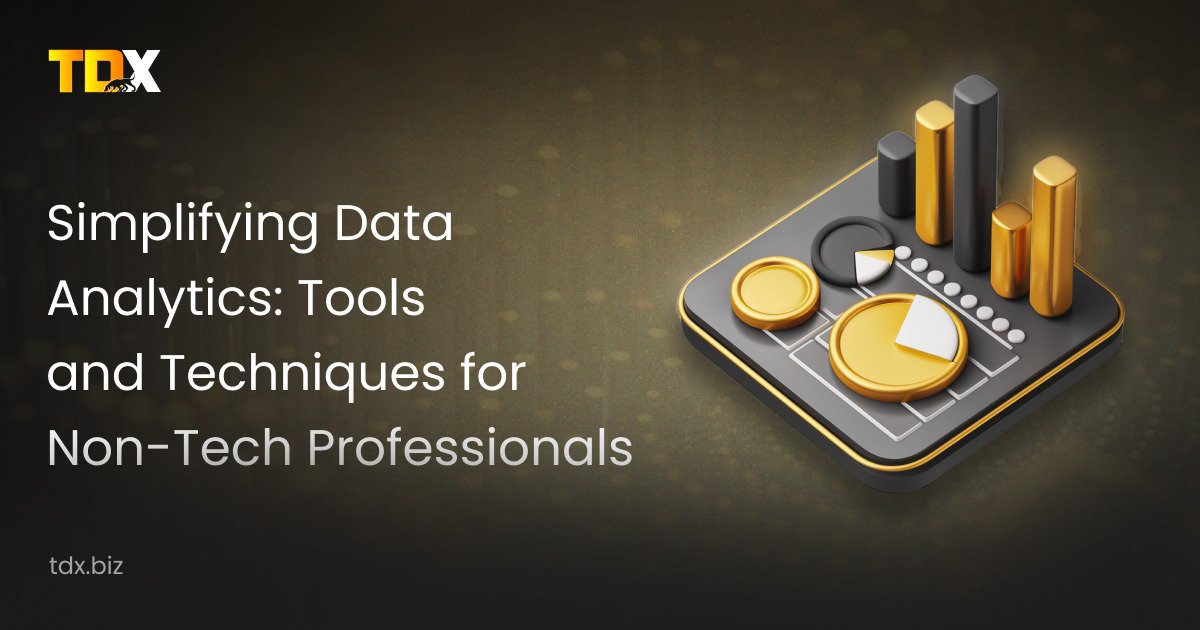




Simplifying Data Analytics: Tools and Techniques for Non-Tech Professionals
Data analytics is essential for informed decision-making and gaining competitive advantages. Yet, non-tech professionals and tech newbies in general often find it challenging to navigate its complexities, agreed?
This blog post breaks down the importance of data analytics and addresses common hurdles faced by those without technical expertise. We will introduce straightforward tools and techniques that make data analytics more accessible, enabling non-tech professionals to confidently leverage data in their work. Intrigued enough? Then read it on!
Why Data Analytics Is So Important
Understanding and leveraging data is critical for several reasons:
Better Decision-Making
Making decisions based on solid data, rather than just intuition, leads to more accurate and reliable outcomes.
Improved Efficiency
Analyzing data helps you spot bottlenecks and inefficiencies in your processes. It might help you streamline and improve all the operations.
Deeper Customer Insights
Data can show you what your customers really want, allowing you to tailor your products and services to meet their needs so much better.
The article from SAS outlines five key reasons why everyone should learn data analytics. Here they are:
1. Gain Problem-Solving Skills
Learning data analytics helps you develop strong analytical thinking and problem-solving skills. These skills are valuable not just in the professional world but also in everyday life. Why? They enable you to approach and solve different kinds of issues much more effectively.
2. High Demand
Data analysts are in high demand across various industries. As more businesses start working with big data, there’s a growing need for professionals who can analyze and interpret this data. This demand translates to higher salaries and better job opportunities for those professionals with analytics skills.
3. Analytics Is Everywhere
Data analytics is pervasive across many industries, from aviation to retail. It is used for everything from route planning to improving customer loyalty programs. As more sectors adopt data analytics, having these skills becomes increasingly valuable.
4. It Is Only Becoming More Important
The importance of data analytics is only going to grow in the future. As the volume of data increases, so does the potential to derive insights from it. Learning analytics now positions you ahead of the curve, which makes you more competitive in the job market overall.
5. A Range of Related Skills
Beyond just working with data, learning data analytics also helps you develop communication and leadership skills. Data analysts often need to explain complex information to non-experts, making good communication skills crucial. What is more, being involved in key decision-making processes helps build strong leadership abilities.
Essential Tools for Non-Tech Professionals
Data analytics tools have evolved to become very user-friendly. It makes them perfect for non-tech professionals and newbies in general. Here are some of the best options available so far:
Microsoft Excel
Microsoft Excel remains a go-to tool for many because of its versatility and simplicity. It offers a range of features ideal for data analysis, such as pivot tables for summarizing large datasets and charts for visual representation. Excel’s built-in functions make complex calculations much easier. It is such a great starting point!
Google Data Studio
Google Data Studio is a free tool that transforms raw data into informative and customizable dashboards and reports. It integrates seamlessly with other Google services like Google Analytics and Google Sheets, making it easy to compile data from various sources. You can create interactive reports to simplify data interpretation.
Tableau Public
Tableau Public is a leading data visualization tool that makes it easy to create and share interactive graphics. Its drag-and-drop interface is designed for ease of use, even for beginners. The extensive support community and resources available through Tableau Public make it a powerful tool for any professional. Try it right away!
Zoho Analytics
Zoho Analytics provides an intuitive platform for detailed data analysis. Its AI-powered insights help uncover trends and generate comprehensive reports with ease. The drag-and-drop interface ensures that creating effective data visualizations is pretty straightforward, even without any coding knowledge.
Qlik Sense
Qlik Sense offers advanced data visualization and exploration capabilities. Its associative model allows users to explore data dynamically, revealing insights that might be missed with fixed queries. Smart visualizations suggest the best ways to present data clearly and effectively.
These tools are designed to make data analytics approachable and practical for everyone. By leveraging them, non-tech specialists might gain valuable insights, drive better decision-making, and execute strategic planning with confidence.
Techniques for Effective Data Analysis
Having the right tools is only part of the solution. Knowing how to use them effectively is crucial. Take a look at those fundamental techniques:
1. Descriptive Statistics
Start with the basics. Descriptive statistics like mean, median, mode, and standard deviation summarize your data and provide a snapshot of its overall characteristics.
2. Data Visualization
Visualizing data helps to highlight trends, correlations, and outliers that might not be immediately apparent from raw data. Charts, graphs, and dashboards might turn complex data into easy-to-understand visuals.
3. Trend Analysis
Track changes over time to identify patterns. This technique is particularly useful for forecasting and strategic planning.
4. Correlation Analysis
Examine the relationships between different variables. Understanding these correlations can help pinpoint factors that influence outcomes.
5. Regression Analysis
Use regression analysis to understand the relationship between dependent and independent variables. This technique is useful for predicting future trends and determining the impact of various factors.
Real-World Impact
The benefits of data analytics are tangible. Consider these findings:
- According to McKinsey, companies using data-driven insights outperform their peers by 85% in sales growth and over 25% in gross margin.
- Forrester reports that businesses leveraging advanced data analytics are 19 times more likely to achieve above-average profitability.
- The Boston Institute of Analytics highlights that one of the primary benefits of learning data science for non-tech professionals is the ability to make data-driven decisions.
Bottomline
Embracing data analytics doesn’t require a tech background. With user-friendly and simple but yet effective tools like Excel, Google Data Studio, Tableau Public, etc., and straightforward techniques like descriptive statistics, data visualization, trend, correlation, and regression analysis, anyone might harness the real power of data.
Start small… You can experiment and gradually build your skills. You will soon discover that data analytics is not just manageable but also incredibly empowering. Good luck!
40,000 readers 🚀 are getting insights with our media





Article
“Is Ethereum dead?” This is a trending argument that is appearing in various crypto communities and media. Which is not…






Guide
Welcome to the beginner’s guide on Trust Wallet, MetaMask, and Exodus—three most common cryptocurrency wallets for managing your crypto assets….






Article
When Venezuela’s inflation hit 189.8% in 2023 [Central Bank of Venezuela, 2023], Maria’s life savings of 200 million bolivars (enough…






Article
For generations, Indians have trusted one investment: fixed deposits (FDs). If you walk into any Indian household, chances are someone…






